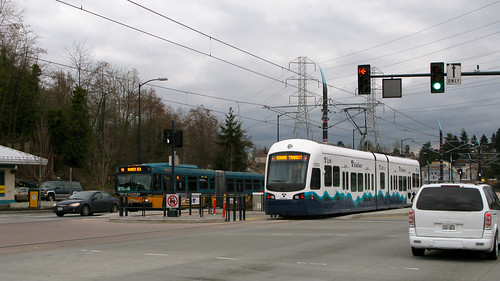Here is my email account record of excerpts from the extensive TC report: (I'll search further later to see if I have a more extensive or complete file, it might be on an older HDD)
Ottawa, Ontario
Summary
Organization
City of Ottawa — Transportation Utilities and Public Works Department, OC Transpo
Status
Started 2001, extended to 2005
Overview
[The O-Train was Ottawa’s first experience with light rail transit. The O-Train travels an 8-km track past five stations, two of which connect to the city’s bus rapid transit system (the “Transitway”), over two bridges and through a tunnel beneath Dow’s Lake. The line serves Carleton University, a major employment centre, and a shopping mall in a densely populated neighbourhood.
The O-Train was initiated to assess the technical feasibility of using an existing rail corridor for rapid transit, to validate expectations about ridership, performance and cost, and to allow proper analysis of possible larger-scale implementation.
[...]
The O-Train travels on an 8-km length of existing freight rail track, and connects to the city’s bus rapid transit system (the “Transitway”) on each end of the line. The existing corridor is owned by Canadian Pacific Railway (CPR). The line serves Carleton University, a major employment centre, and a shopping mall in a densely populated neighbourhood.
The pilot project is unique by North American standards and involves four “firsts.” It is the first time that light rail
passenger trains had been mixed with heavy rail traffic on an existing rail network, and the first time passenger rail services had been operated by a single operator. In addition, this was the first time Bombardier Talent DMU trains had been used anywhere in North America, and the first trains driven by bus operators.
[...]
The O-Train was initiated to:
Assess the technical feasibility of using an existing rail corridor for rapid transit
Validate expectations about ridership, performance and cost
Allow proper analysis of possible larger-scale implementation
[...]
Negotiating an agreement with CPR. With no prior experience in light rail, the region needed considerable outside expertise to implement the pilot project. Municipal officials negotiated a lump sum build/design contract with CPR, which gave them access to CPR’s knowledge and experience and enabled the region to control the project costs and implement the service quickly.
Partner expertise. There were no examples in North America of a single operator passenger train, so municipal officials relied on the expertise of its partners to design and implement the O-Train. More than a dozen partners lent their experience and knowledge to the project. Some of them include:
CPR, as owner of the corridor, engaged Morrison Hershfield (an engineering and management firm) to manage the project. This included design and construction administration, upgrading the lines and maintenance facilities, and building the rail stations.
Bombardier provided and maintains the trains and, with AR Concepts, developed and installed the signaling system.
Transport Canada worked with the city to develop an operating plan that met federal legislation requirements under the Rail Safety Act. The plan includes operating rules, emergency procedures, employee training programs, and a Safety Management System.
[...]
The 8-km line. Prior to the O-Train project, the CPR freight line and its rail yard were seldom used and in poor condition. CPR upgraded the line to accommodate the O-Train, and no other trains use the track except when the O-Train is not operating.
The CPR track crosses two other active rail lines, making the signalling and braking systems (discussed below) important safety elements.
[...]
Bombardier Talent Diesel Multiple Units (DMU). Three Bombardier Talent DMU trains were commissioned. The trains were built in Germany and shipped first to Montreal before arriving in Ottawa in January 2001.
The trains use Clear No. 1 diesel fuel, which contains less sulphur than other grades. The trains comply with exhaust emission requirements of Euro-II contaminant standards (the standards set by the European Union).
Each train weighs 72,000 kg, is 48 metres long, with seating capacity for 137 passengers and standing capacity for 150.
Each train is equipped with two four-stroke diesel engines, water-cooled in-line motors, and a horizontal-shaft design with exhaust gas turbocharger and charge cooler. Top speed is 120 km/hr.
[...]
Recognition. The O-Train has won several awards:
Canadian Urban Transit Association’s Corporate Innovation Award (June 2002)
American Public Works Association’s Project of the Year Award (January 2003)
FCM-CH2M Hill Sustainable Community Award, in the sustainable transportation category (May 2003)
Participants
City of Ottawa
Transport Canada
Human Resources Development Canada
Canadian Pacific Railway
Canadian National Railway
VIA Rail
Carleton University
Public Works and Government Services Canada
National Capital Commission
Ottawa Police Services
Women’s Initiative for a Safe Environment
Transport 2000
Canadian Transport Agency
Local citizens and advocacy groups
[...]
The Bombardier trains were better suited for long distance commuter service. Although the trains were a good choice for this pilot project, as the city proceeds with a more in-depth Ottawa Rapid Transit Expansion Plan Study, alternative vehicles and propulsion systems will be studied. Several requirements including turning radius for inner city use, platform height, train acceleration and vibration would be problematic for downtown service. The new trains being studied are lighter and can be mixed with downtown traffic.
[...]
http://data.tc.gc.ca/archive/eng/programs/environment-utsp-otrainlightrailproject-973.htm
Edit to Add: Hallelujah! TC have restored the file and at the original link above, albeit "archived". Just glancing through the entire file again, there's lots more to dwell on, but this is revealing of the different Council 'Zen' at the time:
Several councillors also visited various European countries and saw, firsthand, how municipalities there had benefited from light rail projects. These councillors recognized that in order to halt urban sprawl, reduce traffic congestion, and avoid gridlock, a new vision for transit was needed.
The input of community and non-profit groups cannot be understated. Transport 2000 was a critical partner on both the steering committee and sounding board. Municipal staff worked with several community groups every step of the way to resolve any issues that would affect local neighbourhoods.
How prescient is that?










